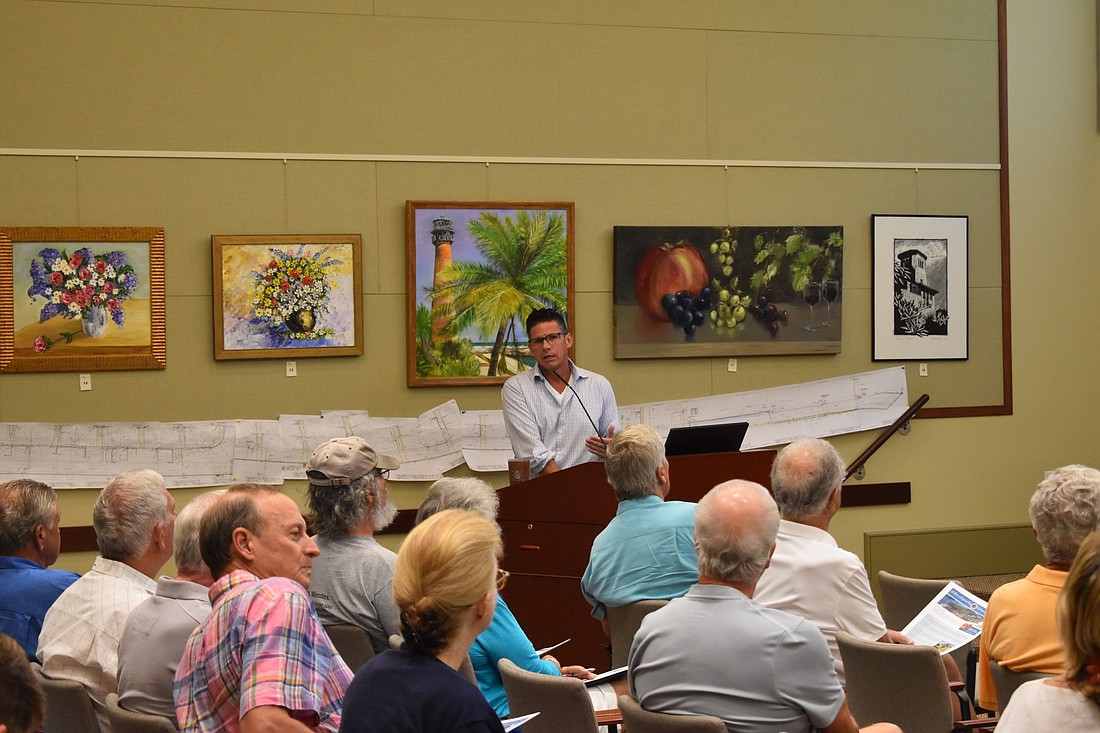- April 19, 2024
-
-
Loading

Loading

Longboat Key staffers and private contracting parties relayed the town’s plan to bring utilities underground to town residents on Monday morning.
The three-and-a-half year, $49.1-million project approved by voters via referenda should begin in about two weeks, according to Project Manager/Town Consultant Mark Porter of CDM Smith.
Public Works Projects Manager James Linkogle, Public Works Director Isaac Brownman and Porter handled the majority of questions from those in attendance during the informational meeting. The main concerns among audience members were:
Brownman, Linkogle and Porter tried to assuage concerns by assuring people Wilco Electrical had done this type of project before (with tight right of ways and expensive properties). As for transformers, “Once they’re there for a couple weeks, you forget they exist,” Porter said.
Linkogle said the project team is meeting with utility locators to get the most accurate representation of where water, gas, electrical and sewer lines are.
“I know for a fact in some neighborhoods they have old wells and old irrigation systems that aren’t marked,” Linkogle said. In cases like this, Linkogle is banking on “historical knowledge” of what’s been done in these areas in the past. Still, Linkogle admitted that the project will inevitably hit irrigation pipes.
“We know where the water line is, we know where the sewer line is, we know where the electrical service lines are, and those kind of things you can easily trace with a tracer,” Linkogle said. “In some cases though, there’s liable to be something that gets missed.”
The goals of the project include “delivery of next-generation broadband, cell phone and wireless technology services,” “high-speed internet service” and to “establish innovative, long-term partnerships with qualified service providers,” according to a handout from the meeting.
In general, Raul Zamarripa, Wilco Electrical’s project manager, Porter, Linkogle and Brownman said the goal is to be minimally invasive while moving all current aerial facilities underground. These aerial facilities include Comcast, Frontier and Florida Power and Light.
The project team is accepting the necessary materials (proper equipment, fiber cable and conduits, for example) from FPL within the next week or week and a half. After this, Phase One of the five-phase project begins in the Country Club Shores area, involving parts of neighborhoods and Gulf of Mexico Drive.
FPL underground utilities work along Gulf of Mexico Drive for Phase One goes from Longboat Club Road to Putter Lane. Phase Two will go from Dream Island Road to Broadway Street. Phase Three will be from Buttonwood Cove South to Country Club Shores; Phase Four will be from Dream Island Road South to the Zota Beach Resort; Phase Five will be from Zota to Buttonwood Cove.
Monday morning’s event was meant to inform residents of what to expect during this process. Wilco Electrical brought a boring machine to show what will be moving along the west side of Gulf of Mexico Drive during Phase One. Directional boring will continue on the east side of Gulf of Mexico Drive for Phase Two. Porter described boring as “a non-invasive way of undergrounding the facilities.” Basically, digging.
The neighborhoods and the Gulf of Mexico Drive portions of the project are being funded separately, although they are essentially the same project. The $49.1-million total comes from $25.25 million for Gulf of Mexico Drive and $23.8 million for the neighborhoods. Property owners will pay their share for the project through 30-year assessments, and, according to Porter, were given the option of paying the whole cost up front.